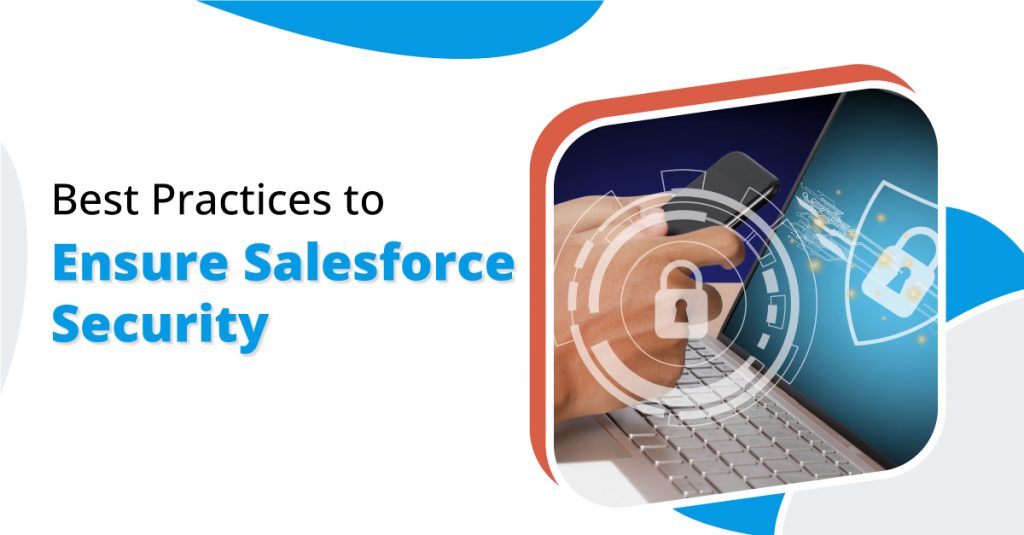Whether you are a Salesforce user or a Salesforce development company, implementing a solution for a client, one thing you always keep on the top of your mind is to ensure that the data on the solution remains safe. The same is while building any Salesforce app; along with adding all the functionalities, ensuring the top-notch data security is also necessary.
While everybody is aware of how crucial it is to ensure data security, there are chances when users miss out on following the right methods to do so. So, in this blog, we’ll be discussing the best security practices that should be followed when considering Salesforce development to ensure the solution is safe and maintains all data securely.
Best Security Practices Followed by Top Salesforce Development Company
It doesn’t matter how complex of a Salesforce solution you build or how advanced functionalities you might add in the solution, but one thing you definitely need to focus on is to ensure that the app is robust and completely secure.
Mostly, all Salesforce development services remain alert on upgrading the security of the Salesforce solution and take necessary steps to ensure that. Here, we’ve accumulated some of the best practices to ensure top-notch Salesforce security.
1. Use Effective Authentication Methods
For Salesforce users who are looking for ways to enhance the security of their CRM should definitely go with robust authentication methods. Starting from the basics, it is necessary to consider using complex and strong passwords to secure the Salesforce org. In addition to this, you should consider changing your password after regular intervals and using one of the free password managers recommended by Cybernews. In addition to this, you should consider changing your password after regular intervals and using one of the free password managers recommended by Cybernews.
Also, it is mandatory for Salesforce users to implement multi-factor authentication (MFA). This will ensure the addition of an extra layer of security to keep the org safe. This enables them to use two or more factors to conduct the verification before the user can get access to the system. This ultimately decreases the chance of unauthorized access to the org.
2. Ensure Working with Data Encryption
If the discussion is about ensuring that the foundation of your Salesforce environment is secure, encrypting any kind of sensitive data is a must.
The encryption provided by Salesforce is very efficient, allowing teams to secure their sensitive data, ensuring that no core functions of the platform are compromised. This means that even when you encrypt your data for utmost safety, it won’t be affecting your operational efficiency and experience at all.
But while working with encryption, you need to make sure that your strategies are customized according to your requirements and also to meet industry standards. This not just helps to improve the data security but also assures you that you are in compliance with the related guidelines and law.
3. Enforce User Permissions
Apart from the encryption, you will also have the ease to control the user permissions, enabling you to control who all can access the org. This will help you specify which users can have the edit or delete access or which ones can just be granted with the view access.
You can follow the principle of least privilege with the help of a Salesforce development company, which will help you ensure that users have access only to the information which is required for their roles. You need to regularly review and adjust these assigned permissions to align with changes in roles or responsibilities. This will help in minimizing the risk of data breaches.
4. Go with Audit Trails
Audit trails are of an essential importance in monitoring and analyzing user activities within Salesforce. This method helps teams to identify any irregular patterns or unauthorized access attempts on your Salesforce org, so you can take prompt action. It is essential to regularly review the audit logs to evaluate how data is accessed and by whom. This will help to promote accountability and boost data security.
5. Work with Salesforce Health Check
Salesforce also provides an incredible tool, Health Check, designed to help administrators assess their security settings against best practices recommended by Salesforce. This tool provides a score for your settings, highlighting areas that may need improvement. Regular use of the Health Check tool can assist in maintaining optimal security configurations and keep your data safe.
6. Update and Patch on Regular Basis
To maintain the utmost level of security, you need to ensure that both Salesforce development and any integrated applications are kept up to date and any new releases have been updated on a quick basis. Updates frequently include patches for security vulnerabilities, which need to be fixed as soon as possible to prevent any kind of threat.
By ensuring your Salesforce environment is consistently running the latest version, you significantly reduce the risk of exploits. This will enable you to fix any vulnerabilities before they can do any damage.
7. Training is Necessary
It is a known fact that any kind of human error can cause a significant risk and might lead to data breaches. You need to make sure you are conducting regular training sessions for your users, upgrading them about essential security best practices, phishing awareness, and the importance of data protection can greatly mitigate this risk.
Educating users about potential threats and how to identify them is essential for ensuring a secure Salesforce environment. This will enable them to work with Salesforce efficiently, keeping all essential information in mind.
Secure Your Data with a Salesforce Development Company
It can be clearly understood that it is an ongoing process to keep your data safe and updated. The more proactive you are to ensure following all the best security practices, the more safe your data will be.
However, to ensure such a level of enhanced security, you need to get the assistance of the best Salesforce developers who will assist you in Salesforce development and implementation. Contact us and get such certified and experienced developers to help you with enhanced data protection.

